BISAC NAT010000 Ecology
BISAC NAT045050 Ecosystems & Habitats / Coastal Regions & Shorelines
BISAC NAT025000 Ecosystems & Habitats / Oceans & Seas
BISAC NAT045030 Ecosystems & Habitats / Polar Regions
BISAC SCI081000 Earth Sciences / Hydrology
BISAC SCI092000 Global Warming & Climate Change
BISAC SCI020000 Life Sciences / Ecology
BISAC SCI039000 Life Sciences / Marine Biology
BISAC SOC053000 Regional Studies
BISAC TEC060000 Marine & Naval
Natural disasters may adversely affect coastal resources potentially leading to coastal habitat restorations that incorporate stakeholders and the general public. Appropriate methodologies for habitat restoration are developed to ensure the outcomes of this project. Currently, seagrass bed restoration by means of asexual and sexual propagation techniques have been used worldwide. However, the experience of seagrass (Enhalus acoroides) habitat restoration in Trang Province noted that to accomplish this project’s strategies involved the application of restoration techniques along with public and stakeholder participation. The application of asexual propagation, specifically the collection of single shoots from donor seagrasses and subsequent transplantation, is a convenient tool. However, from this project results, this process still has conceptual problems as from the large numbers of single shoots collected from donor seagrasses, the survival rate was relatively low. Furthermore, this process was complicated by conflicting interests between local communities near to the donor site and the project’s organizers. In order to reduce said conflicts, other techniques to balance stakeholder interests were instigated by this project, namely the development of both asexual and sexual propagation techniques. This project initiated a sexual propagation technique by the collection of wild seeds of Enhalus acoroides that were subsequently grown in the laboratory before natural habitat transplantation. This project results showed that seeds can be grown rapidly and can be cultured in large numbers. However, this development technique has a limit on rearing time because seedlings were found to be in decline after the third month of the experiment. These problems were compounded by a limiting factor that pushed the project’s organizers to decide to transplant seagrasses from the laboratory to the wild whether a time was seasonally suitable or unsuitable, the planting activity still done forward. This matter may have enhanced the low survival rate situation after seagrass transplantation to the wild. If there is a need to recover a seagrass bed, the above culture and transplantation methodologies should be used in conjunction with repeated periodic plantings until natural ecological function has been restored. In conclusion, further research should be instigated to improve the cultivation method for producing ready to plant seedlings and to improve methods of project operation.
Seagrass restoration, Seagrass seedling, Enhalus acoroides
I. Introduction
Attempts for seagrass restoration have been pioneered over the last 60 years. It was concluded that seagrass restoration is possible to use as a measure to compensate for the loss of seagrass habitats resulting from developmental activities. However, there needs to be an adaptive strategy for this project process [1]. As many seagrass restoration techniques are still at a development stage, several terminologies and seagrass restoration guidelines have been addressed for communication with audiences. The terminologies for seagrass restoration are comprised as follows [2]:
1) ‘Seagrass restoration’ refers to returning a seagrass meadow to its pre-existing condition (i.e. the same species composition, distribution, abundance and ecosystem function).
2) ‘Seagrass rehabilitation’ is a more general term and implies returning seagrasses to an area where seagrass meadows previously existed (but not necessarily the same species, abundance or equivalent ecosystems function).
3) ‘Meadow creation’ is the establishment of seagrass meadows in areas that have not previously been known to support seagrasses.
As with terrestrial grass, seagrass reproduction expresses both asexual and sexual propagation. Based on these reproductive strategies, seagrass transplantation techniques can be divided into vegetative and seed-based methods as concluded in Table 1 below.
.jpg)
Different transplanting and planting methodologies have been developed and tested over the years. Currently, seagrass restoration techniques have only been successful in replacing small areas of habitat, and efforts to replace larger areas often fall short of their goals. In addition, seagrass restoration is a costly process that is still somewhat at the developmental stage therefore, a more research-based approach is recommended. Transplanting and planting success has varied depending on environmental factors such as the restored seagrass species, sediment type, planting time and water current speeds ([1], [2], [3], [4], [5]). The purposes of these experiments focused on developing improved transplantation techniques to achieve higher survivorship from transplanted seagrasses. In addition, they were also concerned with the operational costs of large area restoration projects. Evidently there is a need for inexpensive methodologies, in terms of time, labour and materials. Despite these problems, the guidelines and lessons learned from large-scale restoration projects have been issued for public use in seagrass restorations. However, the strategies and methodologies used by the organizers are still being adapted depending on preliminary experimental results.
In
Despite the seagrass planting method using whole plant material being recognized, problematic matters in methodology such as differences in shoot collection are still observed. Furthermore, after transplantation, using the whole shoot and moving the whole plant to other areas results in no difference between methods in terms of the number of shoots increasing. Moreover, the transplantation technique still shows a lower survival rate. In order to solve the conflict in plantation concept and change the aim of this project, our seagrass restoration project in
II. Experience in
The initial attempts of public seagrass transplantation in
i. Seed-based Method: Seedling production and Field transplants
In January 2009, seagrass seedling was produced in the laboratory as a preliminary experiment using seed from Enhalus acoroides via the annual activities of the Marine Science Club, Faculty of Science and Fisheries Technology, and the Rajamangala University of Technology Srivijaya, Trang Campus. Observations showed that seed from E. acoroides can germinate in seawater under laboratory conditions (Fig. 1). The seedlings were then transplanted in embayment,
In 2011, we decided to make a seagrass unit that utilized a ‘gunny mat’ as a substratum. We hope that designed will be saving time and more comfortable for planting, like landscape decoration. The study was designed in two phases:
- Phase one was a study to germinate seagrasses seed and rear a ‘ready-made’ seedling unit in laboratory condition.
- Phase two was a growing investigation of planted seagrasses under natural conditions.
For phase one, ‘ready-made’ seagrass seedling units were cultured in comparable water circulatory and aeration systems. Growing parameters in terms of the number of leaves produced, leaf length, number of roots produced and root length were recorded from each experiment over 12 weeks. This experiment confirmed that ‘ready-made’ seagrass seedlings can grow under nursery conditions over a 12 week period. Our study showed that the growing of seagrass seedlings did not differ between the two culture systems, (Fig. 2). Based on increased leaf length, the optimum preparation time of seagrasses for a ‘ready-made’ seedling unit is seven weeks. These results suggested that two cultural methods have the potential to allow for seagrass seedling production in preparation for seagrass restoration.
.jpg)
.jpg)
During the second phase, the seedling materials from the laboratory were transplanted using both reared single shoots and seedling units to the natural plots at
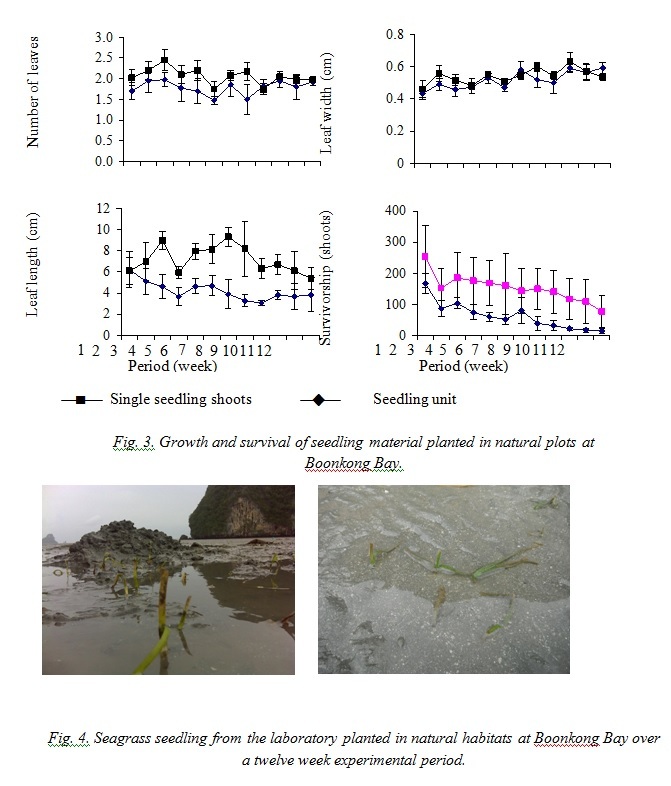

It is time consuming to research and develop seagrass transplantation techniques, therefore we decided to transfer our knowledge and methodology for seagrass restoration in parallel. In the beginning of the seagrass restoration activities, we invited a social organizer to learn and share knowledge with the public sector about seagrass planting and its function in coastal ecology (Fig. 6). The social organizer recognized the benefits of seagrass restoration and was therefore happy to join our seagrass restoration project offering to support us from the pilot scale plantation stage (Fig. 7). Some organizations (e.g. the Provincial Electricity Authority,
.jpg)
ii. Vegetative Methods Development
Enhalus acoroides is the species of seagrasses that have had the most attempts to transplant in the Trang province coastal area. Further, this project had attempted transplantation of these species in several coastal areas of
Case Study: Transplantation at Ko Kangkaao
The seagrass restoration program at Ko (
Table 2. Seagrass Transplantation project operating at Ko Kangkaao,
|
Operational period |
Planting Techniques & Plant Material |
Number of shoots |
|
- March 14, 2009
- January 31, 2010
- February 20, 2011
- March 10, 2012
|
- Planted using seagrass shoots of Enhalus acoroides from the donor site by the Staple Planting Method
- Planted using seagrass shoots of E. acoroides from a donor site by the Staple Planting Method
- Planted using seagrass shoots of E. acoroides from a donor site and seedling grown in the laboratory by the Directed-Single Shoot Planting Method
- Planted using seagrass shoots of E. acoroides from a donor site by the Directed-Single Shoot Planting Method
|
2,000
2,000
2,000
3,000 |
.jpg)
.jpg)
In the third year of the project, the academic sector was consulted. During that time, we believe the planting methodology instigated by the academic sector resulted in low shoot survivorship due to the poor planting knowledge of the participants and poor plant material preparation. In order to increase the survival rate of planted seagrasses, we suggested they revise their planting methodology (Fig. 10). The research sector had set up one planting plot using laboratory cultured seagrass seedling (Fig. 11), therefore after organizational discussions had concluded successfully, planting activity was re-established on February 20, 2011. A seedling monitoring program was conducted in March, July and December 2011, where the length and width of transplanted seagrasses were measured at three different plots:
- Plot A: Shoots planted using seagrass seedling germinated from wild seed and grown in the laboratory.
- Plot B: Planted seagrasses using shoot material from the donor site.
- Plot C: Planted seagrasses that were over two years old as of March 14, 2009 (Fig. 12).
The results of the seagrass monitoring program showed that the plot using natural plant material (Plot C) showed an improved survival rate during the third year over the former year. During seagrass monitoring conducted in March 2011, the survival rate of planted seagrasses using both plant material from the donor site (Plot B) and seedling grown in laboratory (Plot A) was ~70%. However, later monitoring of Plots A and B showed that the number of shoots and the length of leaf blades were decreasing with an associated survival rate of ~40%. It is hypothesized that both the decreased survival rate and reduced length of leaf blades from Plot A and Plot B may be due to the effects of strong wave action during the monsoon season (Fig. 13). In addition, the laboratory cultured seagrasses (Plot A) had a low survival rate after one year post transplantation. These results may possibly relate to the small size of the seedling (~10cm total leaf length) and sediment instability within the plot.
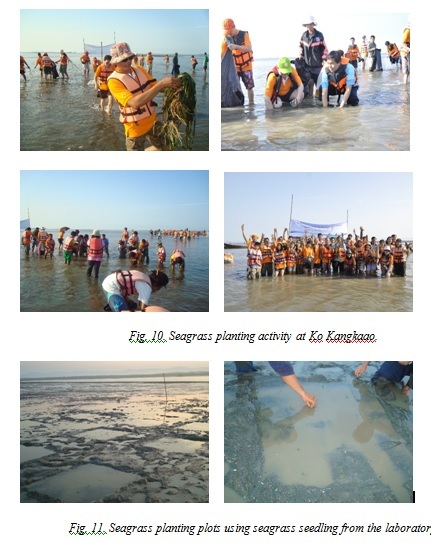

The methodology for the fourth experimental year was based on the results of the planting project in 2011. Therefore, it was suggested to the organizers that the planting protocol was based on planting only single shoots from natural material and to minimize the use of utilizing damaged shoots during planting. This was achieved after detailed consultation with the academic sector regarding how to take care of and how to carefully prepare collected plants from the Trang coastal area donor site. Generally, collected plant material was managed by a villager from the donor site that had been fully trained on the project objectives and status.
For wild plant transplantation, plant material was removed from the sediment at the donor site using spades, the sediment was carefully shaken from the roots and shoots were then kept overnight before transportation to the planting site (Fig. 14). The project organizer also invited local villagers to participate in a ‘planting day’. We had previously prepared the planting plot and volunteers planted the shoots following our experimental design protocol. Post transplantation monitoring concentrated on both growth performance and survival testing. In order to accurately measure the survival percentage of the transplanted shoots, we counted the planted single shoots in a fixed plot. This monitoring was conducted twice, firstly in May 2012 and then March 2013 (Fig. 15). The results showed that shoot leaf length was decreasing, despite the number of leaves being similar during the period of monitoring (Fig. 16). This implied that seagrass leaves had loosened and decayed during the first year after transplantation.
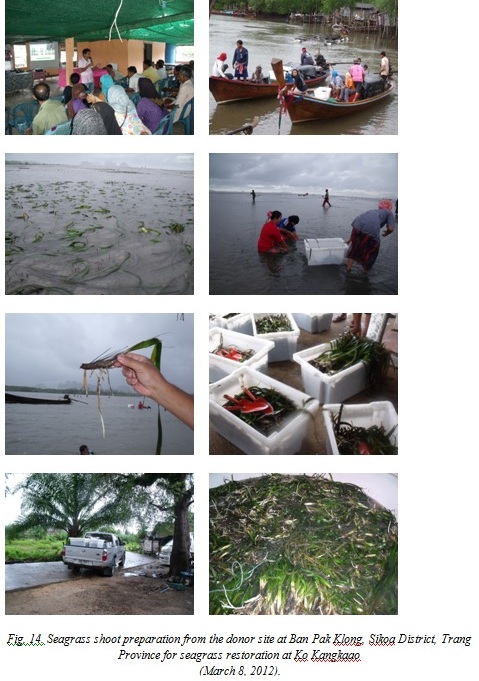

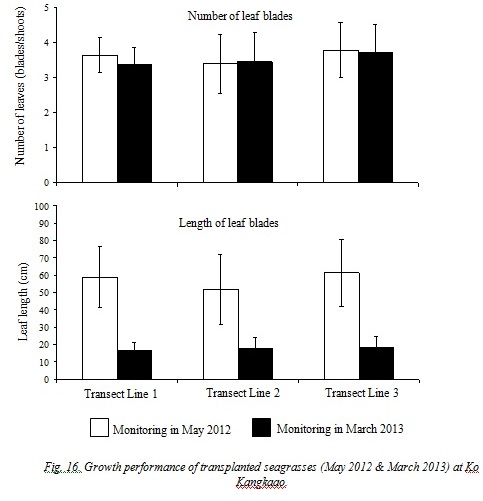
To date (April 2016), a total of four plots of the seagrass (E. acoroides) was planted, established and monitored at Ko Kangkaao. Results from the monitoring process showed that transplanted seagrass survivors can tolerate natural environmental pressures. Shoot leaf lengths from the plots located on the top of sand dunes was relatively short, whereas shoot leaf lengths from the sub-tidal plots was higher (Fig. 17). These findings suggest that the most appropriate planting area for E. acoroides is an area that has physical protection from the elements (in this case sand dunes; Fig 17, Plot DII) that offers relative sediment stability and shelter from wave energy during the monsoon season.
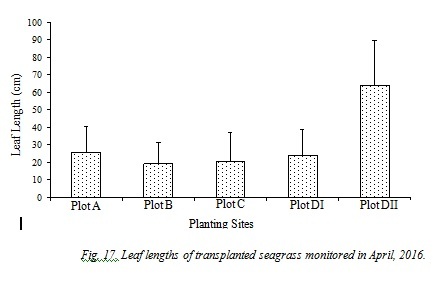
III. Lessons Learned and Recommended Next Steps
Compared to previous reports on seagrass restoration projects from American and
Currently, initial projects focus on small-scale restorations with poor information on the suitability of a planting site. Planting activities are more focused on education and public participation, especially by the C.S.R. who are usually concerned about their organizational image as same as project achievement. Applied knowledge through scientific research in seagrass restoration is a necessary component for successful project organization, especially when public hearings have been established prior to a planting day. Therefore, we operate our projects based on solid scientific research and development-based knowledge. For example, seagrass transplanting activities have to be carefully monitored, recorded and evaluated in order to adapt the planting protocol for the next planting program. We have learned many lessons from our involvement in restoration projects utilizing whole plants and seedling-based transplant methods. Our experiences in this important area of coastal habitat sustainability will be crucial for the future success of seagrass restoration projects.
i. Whole-Plant Transplantation
The planting event at
A major factor commonly found in earlier seagrass restorations that reported low survival rates (e.g. Ko Kangkaao) was that transplanted plants were planted in an exposed area that was relatively calm during the planting season, but subsequently faced strong winds during the rainy season approximately five months later. This occurrence was often discussed in feasibility trials that testing transplanted shoots during candidate site testing prior to restoration ([9], [10], [11]). We recognize that it is important to understand how to facilitate seagrass regeneration and recruitment in challenging areas such as a sandy intertidal area with little or no vegetative sediment support. Our monitoring showed that a selected micro-habitat that offered shelter to transplanted shoots from wave action and strong currents could increase survivorship. Unfortunately, the seagrass restoration project documented in this report had already finished, therefore testing this sites suitability model could not be trialed at this time. It is suggested that the long-term monitoring of this hypothesis should be conducted in order to propose this model as a relocation protocol for similar future planting projects.
ii. Using Laboratory Reared Seedling
Enhalus acoroides is a marine angiosperm. Their fruit and seed are easy to collect in coastal areas within Trang province. The process of seedling production is straight forward. Firstly seeds are collected from donor beds they are then germinated and grown in a controlled seawater environment within holding tanks. Three months-old seedlings are then transplanted using hand planting at the restoration site. This method helps to reduce the risk of complaints from people who object to the idea of removing whole wild plants and it is good in terms of the social image of the restoration project. After the establishment of a Seagrass Seedling Bank at Ban BoIn Farm-Stay, we have produced more than 50,000 shoots per year. To reduce planting labor costs, the planting activities are advertised as part of a touring package of the Ban BoIn Farm-Stay. This form of seagrass restoration project has become popular with around 10,000 tourists joining the restoration project each year. Therefore, it seems probable that the seedling-based seagrass transplantation method has a greater chance to develop in
We are proud of the novel techniques that we have developed over the past five years, although experimental trials have shown poor survival rates. As the culture based shoots are small, the roots are almost always installed at the planting site without being fixed by anchors or staples. This may lead to the loss of these shoots in exposed areas during monsoon season storms. In addition, our field observations have shown, other factors may affect survival such as bioturbation from the settlement of epiphytes on seagrass leaf blades. This possible problem to survivorship requires further experimental testing that follows previous work involving attachment protocols for seedling settlement into sediment ([12], ([13]). The seedling based planting method described above also requires long-term monitoring in order to help educate the local community.
iii. Recommended Next Steps
A major problem facing inexperienced people learning seagrass restoration methodology is how to increase the survival of planted seagrasses. This matter also affects any future seagrass enhancement projects as the negotiation power of project managers to acquire funding is lower when the survival rate of transplanted seagrasses is not good. Consequently, the favored strategy for seagrass restoration in Trang is shifting from using the whole-plants to seedling-based methods. This change in approach toward seagrass site enhancement can also alter the public perception on the meaning of seagrass transplantation due to their belief that it is better to adopt a strategy that minimizes donor bed damage even if that strategy is not the best way to recolonise a damaged seagrass bed. Furthermore, a seedling only-based restoration project may not be able to operate successfully on a large scale if the survival rate remains low. This methods inability to produce seedlings large enough to withstand environmental stresses such as monsoon storms could be the limiting factor in seedling-based restoration. The challenge for the seedling-based method of rearing of seagrasses is how to grow seedling large enough to be suitable for transplantation into the natural habitat. Mariculture is possibly the next step for this method.
Currently, the seagrass restoration projects desire to recolonise using the whole-plant method has been declined. However, this does not imply that a transplantation project using whole-plants is an impossible method. In terms of academic opinion, the consensus is that the whole-plant method still needs to be developed in order to make an informed choice for the most effective method of seagrass restoration. Only after each restoration method has been fully researched, that examines all of the good and bad factors associated with each, can the most appropriate restoration method be utilized.
IV. Acknowledgments
The seagrass restoration research project for
1. C. Ganassin and P.J. Gibbs, “A review of seagrass planting as a means of habitat compensation following loss of seagrass meadow,” NSW Department of Primary Industries, Fisheries Final Report Series No. 96, pp. 1-35. January 2008.
2. S. Seddon, “Going with the flow: facilitating seagrass rehabilitation,”Ecological Management&Restoration, vol. 5, pp.167-179. December 2004.
3. M. Lanuru, “Bottom sediment characteristics affecting the success of seagrass (Enhalus acoroides) transplantation in the westcoast of south Sulawesi (Indonesia),” 2011 3rd International Conference on Chemical, Biological and environmental Engineering IPCBEE, vol. 20, pp. 97-102. 2011.
4. J. Im Park and K. Seop Lee, “Site-specific success of three transplanting methods and the effect of planting time on the establishment of Zostera marina transplants,” Marine Pollution Bulletin, vol. 54, pp. 1238-1248. March 2007.
5. M. M.van Katwijk and D. C. R. Hermus, “Effects of water dynamics on Zostera marina: transplantation experiments in the intertidal Dutch Wadden Sea,” Mar. Ecol. Prog. Ser. vol. 208, pp. 107-118. December 2000.
6. M. Omori, “Degradation and restoration of coral reefs: experience in Okinawa, Japan,” Marine Biology Research, vol. 7, pp. 3-12. 2011.
7. S. Tuxbury, “Rhode Island habitat restoration strategy: seagrasses,” retrieved date, 13 May 2016; http://www.savebay.org/page.aspx?pid=2237
8. R. Davis and F. T. Short, “Restoring eelgrass, Zostera marina L., habitat using a new transplant technique: The horizontal rhizome method,” Aquatic Botany, vol. 59, pp. 1-15. 1997.
9. G. R. Bastyan and M. L., “Cambridge, Transplantation as a method for restoring the seagrass Posidonia australis,” Estuarine, Coastal and Shelf Science, vol. 79, pp. 289-299. April 2008.
10. A. J. Meehan and R. J. West, “Experimental transplanting of Posidonia australis seagrass in Port Hacking, Australia, to assess the feasibility of restoration,” Mar. Poll. Bull., vol. 44, pp. 25-31. 2002.
11. W. Kiswara, E. D. Kumoro, M. Kawaroe and N. P. Rahadian, “Transplanting Enhalus acoroides (L.F) Royle with different length of rhizome on the mudy substrate and high water dynamic at Banten Bay, Indonesia,” Mar. Res. Indonesia, vol. 35, pp. 1-7. 2010.
12. M. E. Zarranz, N. González-Henríquez, P. García-Jiménez and R. R. Robaina, “Restoration of Cymodocea nodosa seagrass meadows through seed propagation: germination in vitro, seedling culture and field transplants,” Botanica Marina, vol. 53, pp. 173-181. 2010.
13. H. Kirman, “Pilot experiment on planting seedling and small seagrass propagules in Western Australia,” Mar. Poll. Bull., vol. 37, pp. 460-467. 1998.







